A Guide to the Most Popular Sharks
There are over 500 known shark species inhabiting our seas and oceans. And an adult human could hold the smallest shark in the palm of their hand. Yet, when we think of these creatures, we first think of big sharks that are capable of harming humans, like we’ve seen them doing in Hollywood movies.
Thus, 5-Minute Crafts has composed a guide to the most popular sharks for you to learn what their differences and similarities are and whether they are really dangerous to humans.
1. White shark
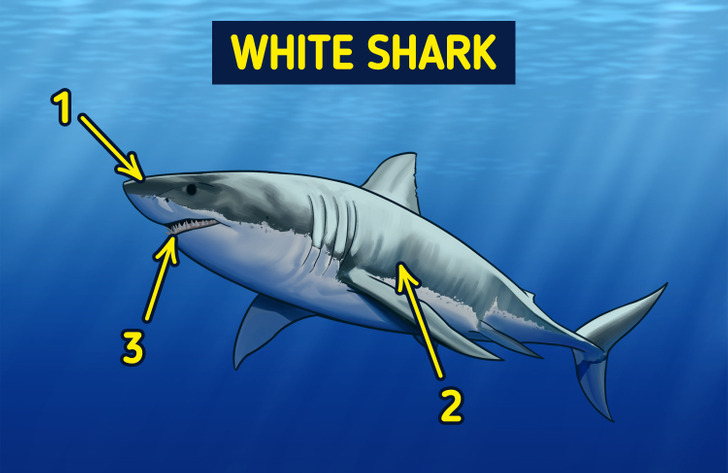
Despite its name, the white shark, also known as the great white, only has a white belly, while the rest of its body could be anywhere between slate brown and black. Its other main features are a conical snout (1), a spindle-shaped body (2), and massive triangular teeth (3).
It inhabits subtropical, tropical, and temperate waters around the world. Grown-up white sharks typically reach between 18 ft (5.5 m) and 21 ft (approx. 6.4 m) in length but could grow up to around 26 ft (8 m), as well. The adult white shark usually weighs up to 4,000 lbs (1,800 kg), albeit specimens weighing over 5,000 lbs (around 2,270 kg) have been documented.
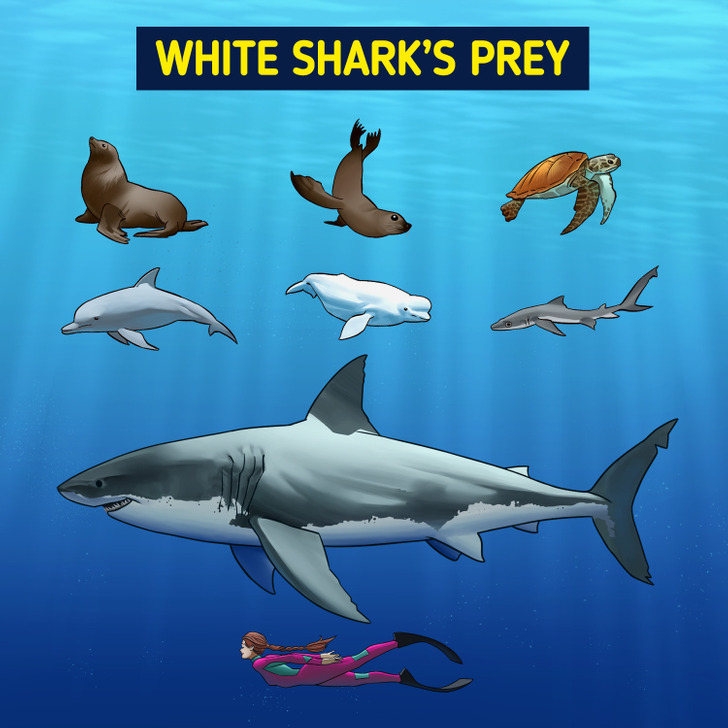
White sharks are superior predators, with youngsters hunting fish and small sharks. Adults prey on marine mammals — such as seals, sea lions, small dolphins, whales, — and sea turtles.
White sharks are usually indifferent to divers and swimmers. However, unprovoked attacks (probably due to mistaken identity) causing serious injuries, and even death, have occurred in the past. Also, some supposed attacks have likely been an unknown object investigation since most bites weren’t fatal to humans.
2. Sawshark
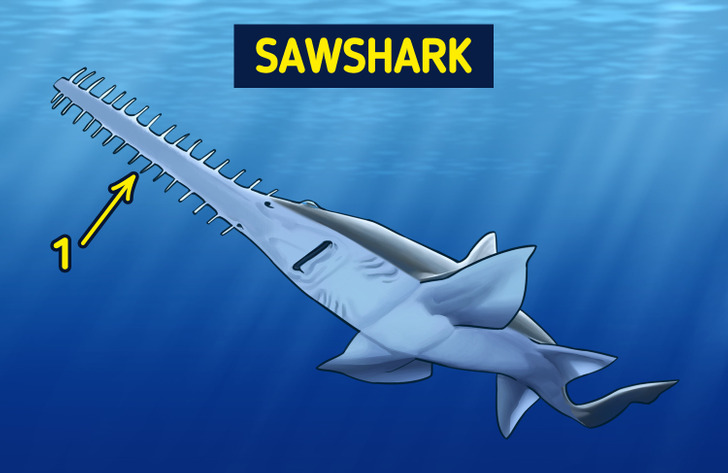
Sawshark, also known as a Bahamas sawshark, is recognizable by its flat, narrow, saw-like rostrum — snout — featuring sharp teeth (1). It has a white belly while the rest of the body is light gray. It also has brownish stripes that dot its snout.
They inhabit the waters around the Bahamas, Florida (the US), and Cuba in the Atlantic Ocean, as well as the West Indian Ocean and West Pacific Ocean. Sawsharks are slender, with their teeth-dotted rostrum accounting for about a third of their average length. They tend to grow up to 5 ft (1.5 m) in length and weigh up to 9.5 lbs (4.3 kg).
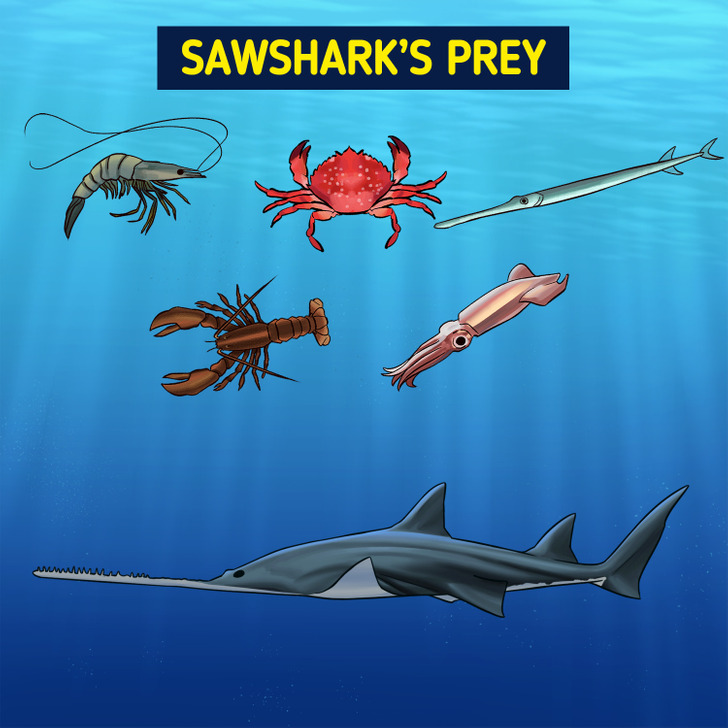
These sharks feed on fish, like cornetfish, squid, and various crustaceans. They use their barbels, sensory organs capable of detecting prey, to locate them. These are found somewhere between the mouth and the tip of their rostrum, or in other words, their snout. Moreover, they have small organs that are able to pick up electricity generated by prey called electroreceptors. Sawsharks are harmless to humans.
3. Tiger shark
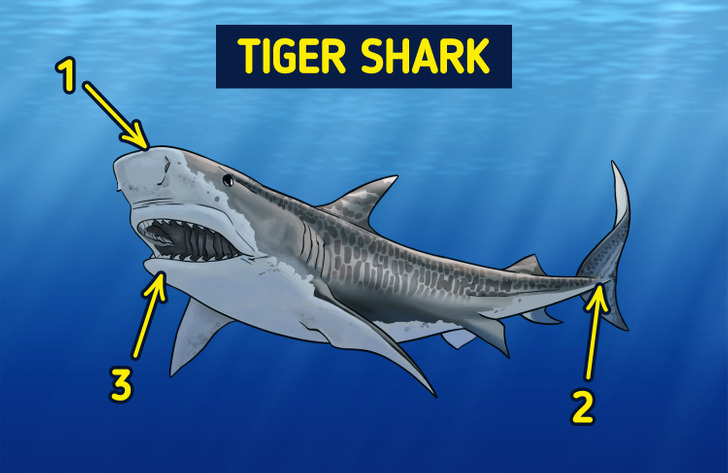
A tiger shark is recognizable by its wide and blunt snout (1) and caudal keel, a lateral ridge (2), at its tail. It also has teeth (3) resembling Celosia flowers which look like diagonal blades. Next, the shark’s belly could be white, pale gray, or dirty yellow, while the rest of the body features either an olive, brownish, gray, or black color. Youngsters have tiger-like stripes, while adults usually lack these markings.
Tiger sharks live in warm, temperate, and tropical seas around the world. Most tiger sharks that humans encountered were between 11 and 14 ft (3.4 to 4.3 m) long. However, they tend to grow to be over 18 ft (5.5 m), and the largest verified specimen was 24 ft (7.4 m) long. Regarding weight, tiger sharks could be up to 1,400 lbs (635 kg).
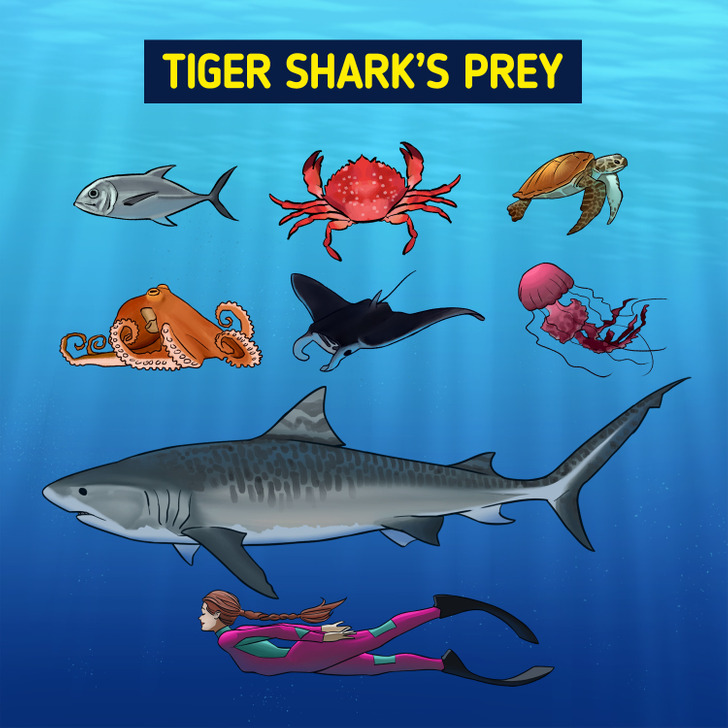
They can eat anything, from garbage to fish to marine reptiles to sea mammals and birds. Tiger sharks usually live solitary lives, albeit they have been seen in small groups of up to 6 specimens.
They are curious and tend to approach and investigate divers. Regarding fatal attacks on humans, tiger sharks are second only to white sharks.
4. Bull shark
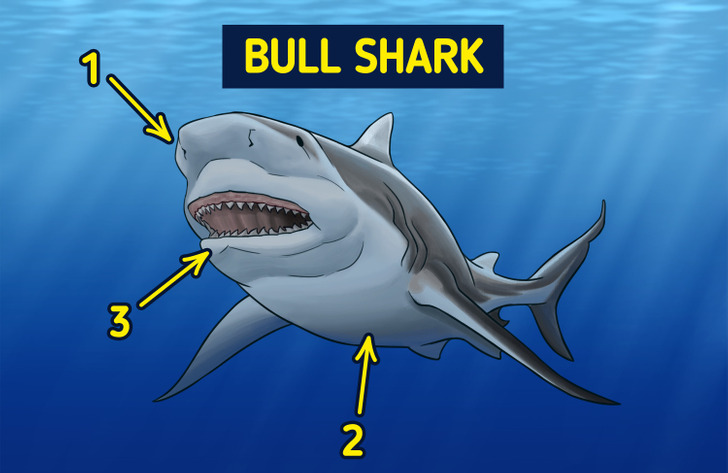
Bull sharks are recognizable by their blunt, round snout (1) and wide, yet relatively short body. They are typically gray with a white belly (2). Their teeth (3) are triangular in the upper jaw and pointed and slender in the lower.
Bull sharks live in coastal, tropical, and subtropical waters, with a tendency to enter rivers. In general, bull sharks are up to 10.6 ft (3.25 m) long. Adults usually weigh between 200 lbs and 500 lbs (91 kg and 227 kg).
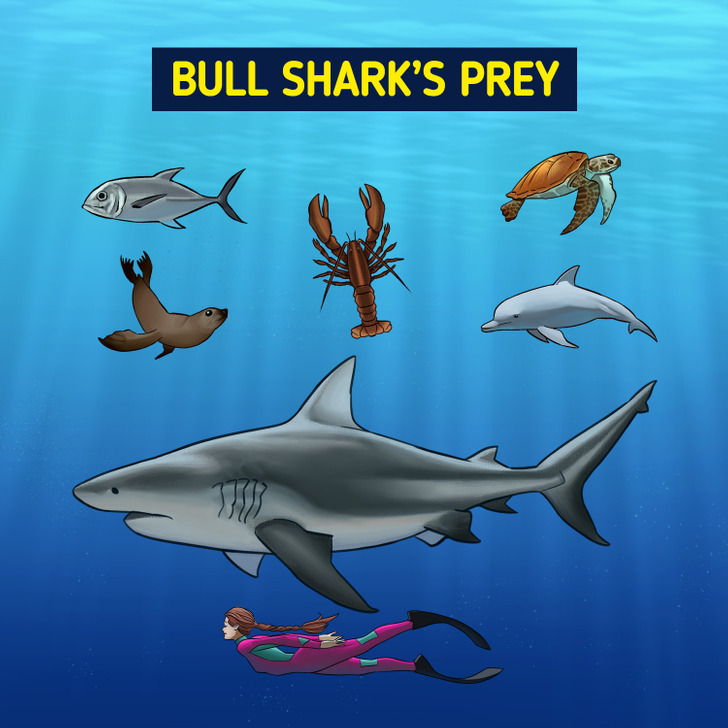
Bull sharks aren’t picky when it comes to feeding. They eat small animals like crabs and lobsters, fish, mammals, smaller sharks, and even garbage.
Bull shark attacks on humans are rare. But, when they attack, they typically inflict bigger damage than the white shark, for example, due to their aggressive hunting style.
5. Great hammerhead shark
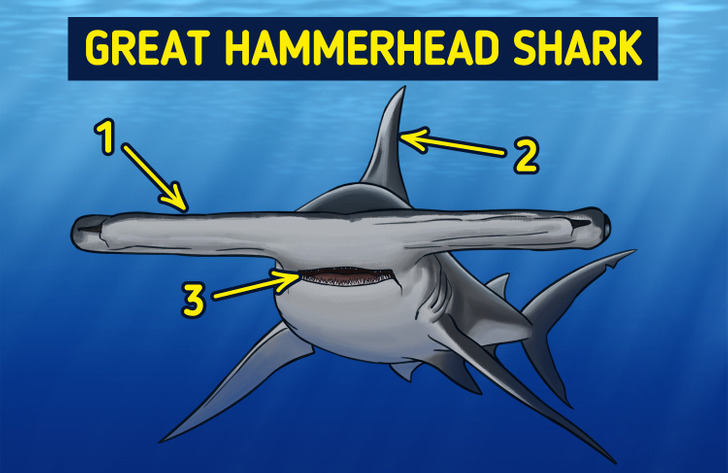
Great hammerhead sharks, featuring hammer-shaped heads (1), are among the most recognizable sharks. Also, their first dorsal fin (2) is pretty tall, their belly is white, and the rest of the body can be olive green, brownish-gray, or anything in between. Finally, they have serrated teeth (3).
They inhabit circumtropical waters — distributed throughout the tropics or flanking them — and can be found near and away from the shore. Most great hammerheads encountered by divers were between 10 and 14 ft (3 m to 4.3 m) long. Still, they can grow up to 20 ft (6 m) in length. The largest hammerhead ever recorded weighed around 990 lbs (450 kg).
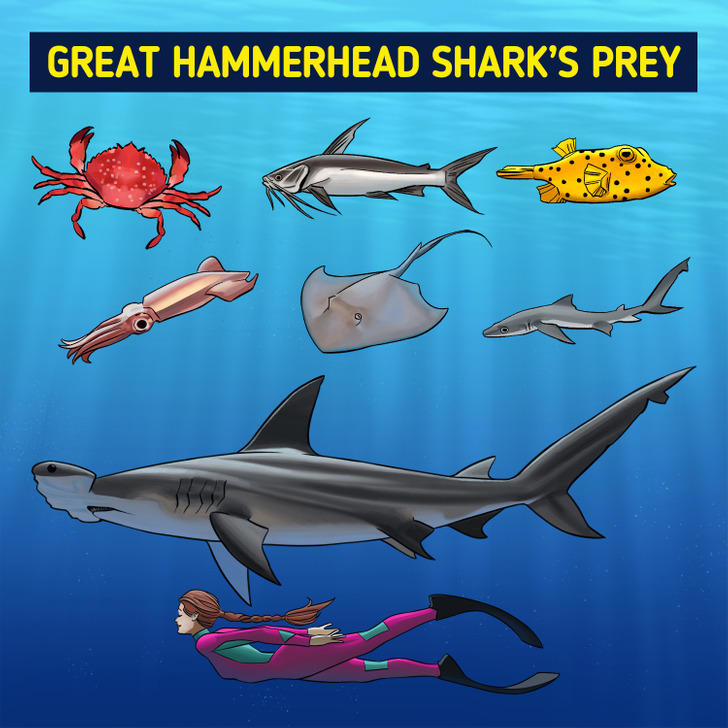
Great hammerhead sharks feed on stingrays, squid, crabs, and various fishes, including catfish, sardines, and boxfish. These solitary sharks can even prey on other sharks.
Great hammerheads aren’t dangerous to humans, despite various beliefs. Even when approaching divers, great hammerhead sharks don’t display hostility. So far, only a few incidents have involved humans and great hammerheads or their relatives smooth and scalloped hammerhead sharks.
6. Nurse shark
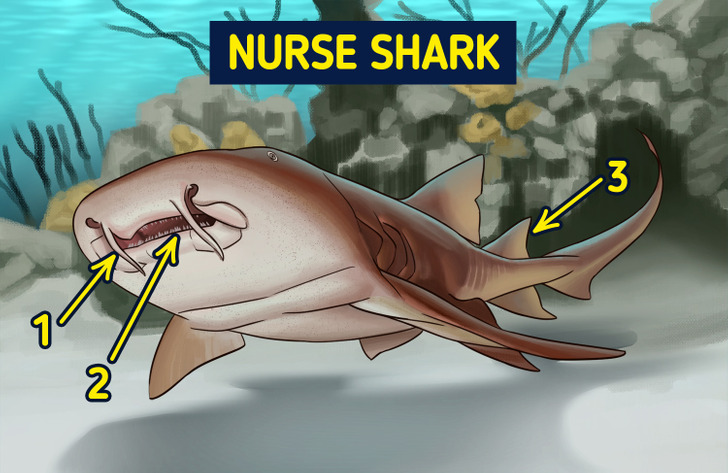
Nurse sharks have brown, yellow-brown, or grey-brown bodies. They also feature nasal barbels (1), short extensions next to the nose allowing them to notice what’s going on around them, and small, serrated teeth (2). Moreover, they have triangular dorsal fins (3), that are about the same size, on their back that improve their stability when swimming.
These sharks inhabit the Atlantic and Eastern Pacific oceans. Nurse sharks grow up to 10 ft (3 m) in length, in general, while the largest one spotted supposedly measured 14 ft (4.3 m). They weigh between 200 lbs and 330 lbs (90 kg to 150 kg).
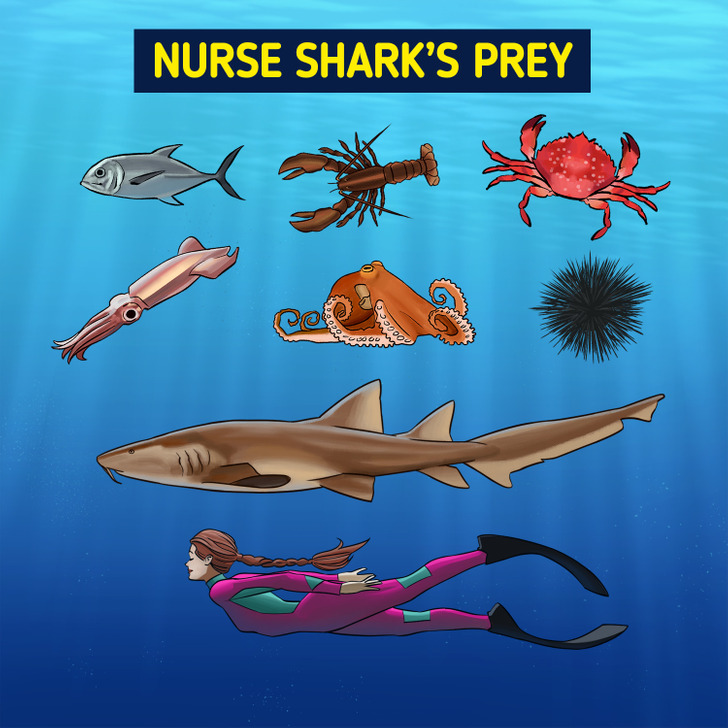
Nurse sharks prey on small fish and invertebrates, like lobsters, crabs, octopuses, and sea urchins. Being nocturnal animals, they typically hunt at night and then are lethargic during the day, for the most part.
These sharks are indifferent and harmless to humans unless provoked.